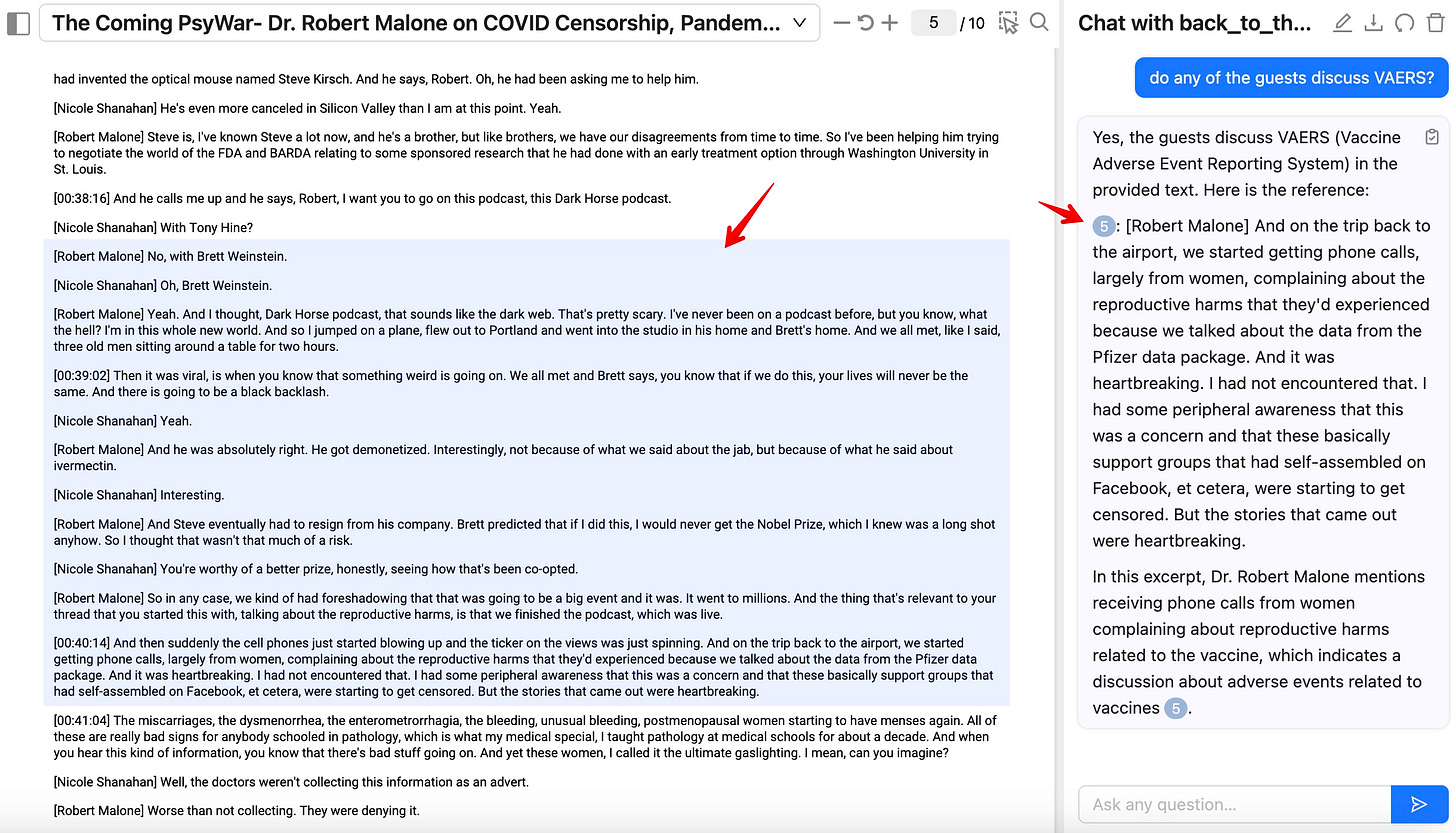How AI helps bypass censorship
What if you could chat with the transcripts of videos in a Rumble channel?
One of the most important websites in the fight against censorship is Rumble.
However, compared to the search capabilities of Google + YouTube, Rumble is still quite far behind.
For example, the chapters you see in the search result below are AI generated.
And clicking on one of the thumbnails takes you to an interstitial result page, which provides a way to play the video and also jump to the specific chapter.
And of course, you can also jump to the YouTube video page from this search result.
It is going to be quite a while before you can see anything resembling this for Rumble videos, if ever :-)
But we don’t have to wait till Google provides this service for Rumble videos. Instead, we can use the AI tools we have at our disposal and start building tools to bypass Google search.
An example
For example, I used my AudioJots Toolkit for Rumble1 to create easy-to-skim transcripts for the longer videos on Nicole Shanahan’s2 Rumble channel.
This is the Airtable I created based on the Rumble channel. You can actually click on the HTML column for each video to see what the skimmable transcript looks like.
You can click on “Use this data” to import the entire table into your Airtable account3.
How does this help bypass censorship?
This can help in many different ways:
Search inside transcript
It provides a way for people to search inside the text of all the videos in the channel to see if a specific keyword4 is present. This helps people discover if some specific topic is being discussed in your video.
Post as Substack article
If you post the video transcript as a Substack article, you will also encourage people to link to your website (because it includes the transcript). Since Substack is focused on getting email subscribers5, this means you will also get some people signing up on your mailing list. In turn, this allows you to notify them via email6 every time you post a new video transcript.
Does it help bypass censorship? Well, how did you find out about this article? :-)
Link to other content on your website
If you post the transcript on your website, people can easily skim the transcript of a video and decide if they want to watch the entire video. It will probably get more people to watch your video.
You can also link to other articles and previous videos from within a transcript, which can help people find more of your content more easily. Contrast this with sending them to a video on the Rumble website, where they are only more likely to click away to a different channel.
This is especially relevant for podcast style Rumble channels, where you might refer to a previous guest in one of your interviews. If you publish a transcript, you can just link directly to that episode’s transcript.
Niche search engines
If many people create this type of Airtable for their Rumble channel, we can aggregate all the information and create distributed search engines7. For example, it would be possible to create search engines dedicated to vaccine safety research, or dedicated to FOIA document discoveries etc.
Contrast this to how difficult it would be to find information on these topics on Google, Bing and other popular search engines.
Chat with the transcripts of videos in your Rumble channel
Doing all this does take some work, although my toolkit can automate some of it and save you a lot of time.
But once you complete it, the Python script produces a folder full of PDF files (of video transcripts).
You can upload all these PDF files to a single folder in a service like ChatPDF and get answers to questions across the entire folder (meaning the entire video library).
The nice thing about ChatPDF is that it provides some citations for where you can find the information in the video transcript. By clicking on this citation link, you will be taken to the appropriate page in the PDF file. This way, you can infer the timestamp and watch the appropriate segment in the video if you would like.
There are also some other nice perks when you use the ChatPDF service.
Obviously, you can simply ask GPT4 to generate a summary of a single video transcript. This is now a very common use case.
But in addition, the ChatPDF interface also allows you to select one of the bullet points and request a longer explanation.
This helps people to learn about this topic in more detail, and then they can watch the video to get more details.
Discount
Use this link to get 80% off discount on the AudioJots Toolkit until end of this week.
I am making the toolkit a paid product again, as I have decided to expand the scope of the product to add some GUI tools in the future (which would incur support costs)
I doubt if it is the “official” channel. I chose that channel because it had a diverse set of topics and did not have too many videos :-)
I might update this Airtable as I develop my course, so I will be periodically deleting and refreshing the data
Airtable search can only search for contiguous keywords, like the FIND feature in your browser, so it is not very useful as a “search engine”
Admittedly, some people find it a bit annoying
In fact, the default setting on Substack is to send an email notification containing the entire article (up to some word limit), every time you publish an article.
If anyone is interested, I can add some material into the course on how to do this









